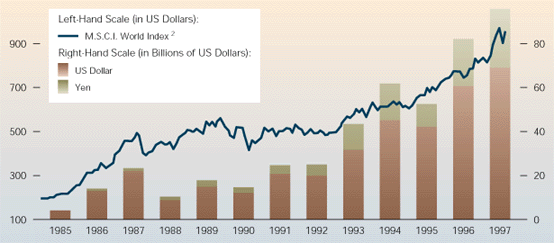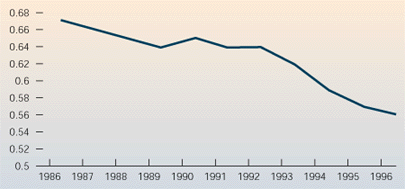Texts belong to their owners and are placed on a site for acquaintance.
Growth of the Global Capital Market
In the introduction, we noted that there has been rapid growth in the size of the global capital market in recent years. The following figures add some substance to this claim.9 Figure 11.4 shows the growth in international bank lending from 1983 to the end of 1997. As can be seen, international bank lending increased rapidly over this period, hitting a record $5.3 trillion by the end of 1997. Figure 11.5 shows the quarter-by-quarter increase in international bond issuance, from 1994 through 1997. By 1997, international bond issues were running at over $250 billion per quarter, up from $110 to $150 billion a quarter in 1994. Figure 11.5 also gives details of the currency in which most international bonds were issued. The US dollar has been the favored currency for issuing international bonds. Figure 11.6 shows the volume of international equity offerings between 1985 and 1997. Again, there has been a steep increase, with international equity issues closing in on $100 billion in 1997, up from about $4 billion in 1985. Figure 11.6 also shows details of the Morgan Stanley Capital Market International World Stock Market Index. As can be seen, the value of world stock markets has also increased substantially. It is easier to raise capital from new stock issue in a climate where stock markets are rising than in one where stock markets are declining in value. A decline in the value of world stock markets, such as occurred toward the end of 1987, makes it more difficult for companies to raise additional funds from international equity issues.
The data contained in Figures 11.4 to 11.6 clearly illustrate the rapid growth in the size of the global capital market in recent years. What factors allowed the international capital market to bloom in the 1980s and 1990s? There seem to be two answers--advances in information technology and deregulation by governments.
Information Technology
Financial services is an information-intensive industry. It draws on large volumes of information about markets, risks, exchange rates, interest rates, creditworthiness, and so on. It uses this information to make decisions about what to invest where, how much to charge borrowers, how much interest to pay to depositors, and the value and riskiness of a range of financial assets including corporate bonds, stocks, government securities, and currencies.
Because of this information intensity, the financial services industry has been revolutionized more than any other industry by advances in information technology since the 1970s. The growth of international communications technology has facilitated instantaneous communication between any two points on the globe. At the same time, rapid advances in data processing capabilities have allowed market makers to

Figure 11.5
International Bond Issues and the US Dollar Exchange Rate.
Source: Bank for International Settlements database; Euromoney data; Bank of England data.

Figure 11.6
International Equity Offerings and Equity Price Developments
Source: Bank for International Settlements database; Euromoney data.
absorb and process large volumes of information from around the world. According to one study, because of these technological developments, the real cost of recording, transmitting, and processing information has fallen by 95 percent since 1964.10
Such developments have facilitated the emergence of an integrated international capital market. It is now technologically possible for financial services companies to engage in 24-hour-a-day trading, whether it is in stocks, bonds, foreign exchange, or any other financial asset. Due to advances in communications and data processing technology, the international capital market never sleeps. San Francisco closes one hour before Tokyo opens, but during this period trading continues in New Zealand.
The integration facilitated by technology has a dark side.11 "Shocks" that occur in one financial center now spread around the globe very quickly. The collapse of US stock prices on the notorious Black Monday of October 19, 1987, immediately triggered similar collapses in all the world's major stock markets, wiping billions of dollars off the value of corporate stocks worldwide. However, most market participants would argue that the benefits of an integrated global capital market far outweigh any potential costs.
Deregulation
In country after country, financial services have been the most tightly regulated of all industries. Governments around the world have traditionally kept other countries' financial service firms from entering their capital markets. In some cases, they have also restricted the overseas expansion of their domestic financial services firms. In many countries, the law has also segmented the domestic financial services industry. In the United States, for example, commercial banks are prohibited from performing the functions of investment banks, and vice versa. Historically, many countries have limited the ability of foreign investors to purchase significant equity positions in domestic companies. They have also limited the amount of foreign investment that their citizens could undertake. In the 1970s, for example, capital controls made it very difficult for a British investor to purchase American stocks and bonds.
Many of these restrictions have been crumbling since the late 1970s. In part, this has been a response to the development of the Eurocurrency market, which from the beginning was outside of national control. (This is explained later in the chapter.) It has also been a response to pressure from financial services companies, which have long wanted to operate in a less regulated environment. Increasing acceptance of the free market ideology associated with an individualistic political philosophy also has a lot to do with the global trend toward the deregulation of financial markets (see Chapter 2). Whatever the reason, deregulation in a number of key countries has undoubtedly facilitated the growth of the international capital market.
The trend began in the United States in the late 1970s and early 80s with a series of changes that allowed foreign banks to enter the US capital market and domestic banks to expand their operations overseas. In Great Britain, the so-called Big Bang of October 1986 removed barriers that had existed between banks and stockbrokers and allowed foreign financial service companies to enter the British stock market. Restrictions on the entry of foreign securities houses have been relaxed in Japan, and Japanese banks are now allowed to open international banking facilities. In France, the "Little Bang" of 1987 is gradually opening the French stock market to outsiders and to foreign and domestic banks. In Germany, foreign banks are now allowed to lend and manage foreign deutsche mark issues, subject to reciprocity agreements.12 All of this has enabled financial services companies to transform themselves from primarily domestic companies into global operations with major offices around the world--a prerequisite for the development of a truly international capital market. As we saw in Chapter 5, in late 1997, the World Trade Organization brokered a deal that removed many of the restrictions on cross-border trade in financial services. This deal should encourage further growth in the size of the global capital market.
In addition to the deregulation of the financial services industry, many countries beginning in the 1970s started to dismantle capital controls, loosening both restrictions on inward investment by foreigners and outward investment by their own citizens and corporations. By the 1980s, this trend spread from developed nations to the emerging economies of the world as countries across Latin America, Asia, and Eastern Europe started to dismantle decades-old restrictions on capital flows. Figure 11.7 illustrates the consequences. Since 1985, an index of capital controls in emerging markets that is com
Figure 11.7
Index of Capital Controls in Emerging Markets
Note: Index ranges from 0 to 1. 0 = No capital controls, 1 = Tight capital controls.

Source: IMF database.
puted by the IMF has declined from a high of 0.66 to around 0.56 (the index would be 1.0 if all emerging economies had tight capital controls, and 0.0 if they had no controls). According to the World Bank, capital flows into the emerging economies of the world went from less than $50 billion in 1990 to over $336 billion in 1997.13
As of 1998, the trends toward deregulation of financial services and removal of capital controls were still firmly in place. Given the benefits associated with the globalization of capital, the growth of the global capital market mapped out in Figures 11.4 to 11.6 can be expected to continue for the foreseeable future. While most commentators see this as a positive development, there are those who believe that there are serious risks inherent in the globalization of capital.
Global Capital Market Risks
Some analysts are concerned that due to deregulation and reduced controls on cross-border capital flows, individual nations are becoming more vulnerable to speculative capital flows. They see this as having a destabilizing effect on national economies.14 Harvard economist Martin Feldstein, for example, has argued that most of the capital that moves internationally is pursuing temporary gains, and it shifts in and out of countries as quickly as conditions change.15 He distinguishes between this short-term capital, or "hot money," and "patient money" that would support long-term cross-border capital flows. To Feldstein, patient money is still relatively rare, primarily because although capital is free to move internationally, its owners and managers still prefer to keep most of it at home. Feldstein supports his arguments with statistics that demonstrate that although $1.2 trillion flows through the foreign exchange markets every day, "when the dust settles, most of the savings done in each country stays in that country."16 Feldstein argues that the lack of patient money is due to the relative paucity of information that investors have about foreign investments. In his view, if investors had better information about foreign assets, the global capital market would work more efficiently and be less subject to short-term speculative capital flows. Feldstein claims that Mexico's economic problems in the mid-1990s were the result of too much hot money flowing in and out of the country and too little patient money. This example is reviewed in detail in the accompanying Country Focus.
A lack of information about the fundamental quality of foreign investments may encourage speculative flows in the global capital market. Faced with a lack of quality information, investors may react to dramatic news events in foreign nations and pull their money out too quickly. Despite advances in information technology, it is still difficult for an investor to get access to the same quantity and quality of information about foreign investment opportunities that he can get about domestic investment opportunities. This information gap is exacerbated by different accounting conventions in different countries, which makes the direct comparison of cross-border investment opportunities difficult for all but the most sophisticated investor (see Chapter 19 for details). For example, German accounting principles are very different from those found in the United States and can present quite a different picture of the health of a company. Thus, when the Germany company Daimler-Benz translated its German financial accounts into US-style accounts in 1993, as it had to do to be listed on the New York Stock Exchange, it found that while it had made a profit of $97 million under German rules, under US rules it had lost $548 million!17
Given the problems created by differences in the quantity and quality of information, many investors have yet to venture into the world of cross-border investing, and those that do are prone to reverse their decision on the basis of limited (and perhaps inaccurate) information. However, if the international capital market continues to grow, financial intermediaries likely will increasingly provide quality information about foreign investment opportunities. Better information should increase the sophistication of investment decisions and reduce the frequency and size of speculative capital flows. Although concerns about the volume of "hot money" sloshing around in the global capital market have recently increased as a result of the Asian financial crisis, IMF research suggests there has not been an increase in the volatility of financial markets over the past 25 years.18